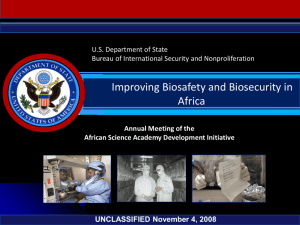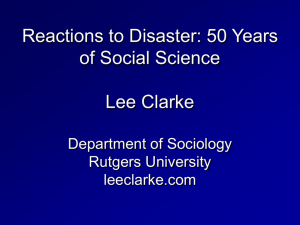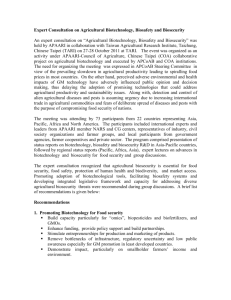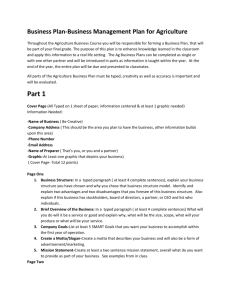Journal of Biosecurity, Biosafety and Biodefense Law Biosecurity, Biosafety & Biodefense Law
advertisement
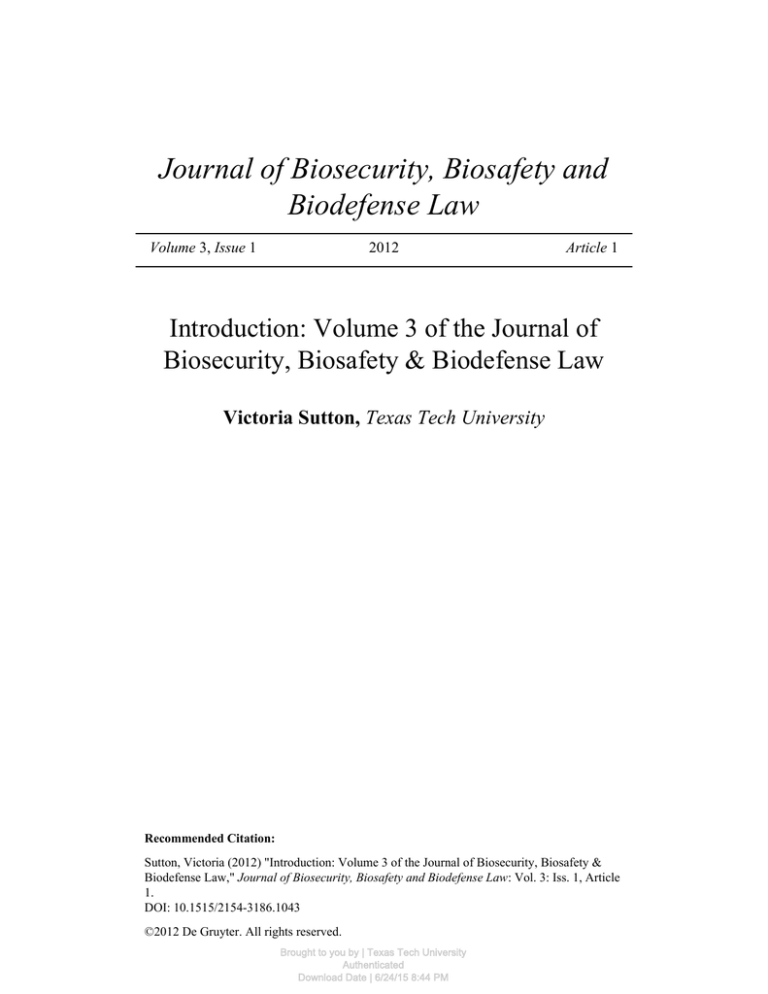
Journal of Biosecurity, Biosafety and Biodefense Law Volume 3, Issue 1 2012 Article 1 Introduction: Volume 3 of the Journal of Biosecurity, Biosafety & Biodefense Law Victoria Sutton, Texas Tech University Recommended Citation: Sutton, Victoria (2012) "Introduction: Volume 3 of the Journal of Biosecurity, Biosafety & Biodefense Law," Journal of Biosecurity, Biosafety and Biodefense Law: Vol. 3: Iss. 1, Article 1. DOI: 10.1515/2154-3186.1043 ©2012 De Gruyter. All rights reserved. Brought to you by | Texas Tech University Authenticated Download Date | 6/24/15 8:44 PM Introduction: Volume 3 of the Journal of Biosecurity, Biosafety & Biodefense Law Victoria Sutton Abstract The purpose of this document is to provide an introduction and overview regarding the substantive materials included in Volume 3 of the Journal for Biosecurity, Biosafety and Biodefense Law. This volume raises new and important legal issues within the field of biosecurity, biosafety and biodefense law, both from a practical as well as a theoretical perspective. KEYWORDS: introduction, welcome Brought to you by | Texas Tech University Authenticated Download Date | 6/24/15 8:44 PM Sutton: Introduction June 2012 To the Readers, We are pleased to publish Volume 3 of the Journal for Biosecurity, Biosafety and Biodefense Law. This volume raises new and important legal issues within the field of biosecurity, biosafety and biodefense law, both from a practical as well as a theoretical perspective. I thank the anonymous peer reviewers and Board of Editors for their steadfast dedication to this growing area of law and to the Journal. Sincere thanks also goes to our Student Executive Board, Editor-in-Chief, Marshall Meringola; Executive Managing Editor, Austin Franklin; Lead Articles Editor, Gabriel Sustaita; and the Organizational Development Chair, Austin Carrizales, who each devoted themselves to preparing articles for publication and day-today management of Volume 3 of the Journal. Additionally, our outstanding Board of Student Associate Editors ensured that every detail of articles editing was skillfully executed to meet the deadlines for Volume 3. Finally, a special thanks to Professor Brie Sherwin who has continued to serve the Journal as Managing Editor, and her contributions are vital to the Journal’s success. The articles selected for Volume 3 address six subject-matter areas. The lead article, Whistleblower and Liability Protections for Scientific Laboratory Employees by Jarod Gonzalez and Victoria Sutton, addresses a timely issue involving the proposed regulatory changes to the biosafety and biosecurity regulations, 42 C.F.R. § 73, which were proposed on October 3, 2011. These changes have the potential to impact the culture of biodefense research with regard to personal assurances and obligations to act on co-workers behavior. Following the lead article, the first group of articles addresses the importance of establishing jurisdiction, and the challenges of determining proper jurisdiction during an international biosecurity incident. The second group of articles addresses the unique area of Biocriminology, as the articles consider the interaction between criminal laws and the prosecution of biosecurity crimes. The third section provides an insightful article which examines biosecurity and biosafety concerns that may arise at our nation’s border. The fourth group of articles looks at particular areas of science and medicine that are largely unregulated, which may present an increased risk for biosecurity threats. The fifth group of articles provides individual analyses of national and international Published by De Gruyter, 2012 Brought to you by | Texas Tech University Authenticated Download Date | 6/24/15 8:44 PM 1 Journal of Biosecurity, Biosafety and Biodefense Law, Vol. 3 [2012], Iss. 1, Art. 1 responses to three recent, significant disease outbreaks and inquires whether the global community is prepared to respond to pandemics. The first section addresses the importance of establishing jurisdiction and the challenges of determining jurisdiction related to biosecurity matters. Lorenzo Sierra begins this section by evaluating the challenges of establishing jurisdiction when a biological incident occurs, or is identified, during air travel, high above clearly defined national borders, in his article entitled, Who has Jurisdiction in the Air During an International Health Emergency? Zack Allen, in his article, Who’s Got Yellow Rain? An Analysis and Revisit of the Yellow Rain Incident and the Possible Involvement of the World Health Organization, considers whether, under today’s international biosecurity governance system, the response to the Yellow Rain Incident of the 1970s would have been improved. The second section addresses the unique interaction between criminal law and the prosecution of biosecurity crimes. Lisa Danley constructs an important foundation for this interplay by examining the challenges within the field of Biocriminology in her article entitled, Difficulty in Trying Biocrimes. Courtney Grafft provides an analysis of a real-world application of Biocriminology during the United States anthrax-letter investigation in her article entitled, A Legal Analysis of the Search Warrants of the Amerithrax Case. A third section features one article on the timeless topic of biosecurity and biosafety at our nation’s border. The article, The Role of Regulations in Response to the Bioterrorism Threat to Food Imports, authored by Bryan Tate, examines existing food security protections in place at the United States border, and he suggests ways in which such security measures can be enhanced. The fourth section identifies particular areas of science and medicine that present increased risks of biosecurity threats due to limited regulations. Jared Burr begins this section by addressing the international risks associated with the unregulated biological activities of private citizens in his article entitled, The Mad (and Not so Mad) Scientist Next Door: Regulating Do It Yourself Biology in the International System. Taylor Floyd then evaluates the biosecurity gaps that exist within the United States’ blood donation system in his article entitled, Death Disguised as Life: Blood Donations. The fifth section includes articles which highlight two, recent major disease outbreaks, evaluate the biosecurity response taken during each outbreak, and discuss whether the global community is prepared to address future pandemics. Evan Jackson shares an in-depth review of Foot and Mouth disease as it has occurred in the past, and how the international community is prepared to respond in the future in her article entitled, Foot and Mouth, Then and Now. Finally, in an article entitled, Swine Flu Again: Will the WHO’s Plan Prove to 2 Brought to you by | Texas Tech University Authenticated Download Date | 6/24/15 8:44 PM Sutton: Introduction be a Success for the Global Community and Will the U.S. Lead the Way?, Katie Maxwell reviews the response to the 2009 H1N1 outbreak and conducts a comparative analysis of emergency response plans adopted by six influential nations within the international pandemic response network. Sincerely, Victoria Sutton, MPA, PhD, JD Paul Whitfield Horn Professor Chief Editor Published by De Gruyter, 2012 Brought to you by | Texas Tech University Authenticated Download Date | 6/24/15 8:44 PM 3
